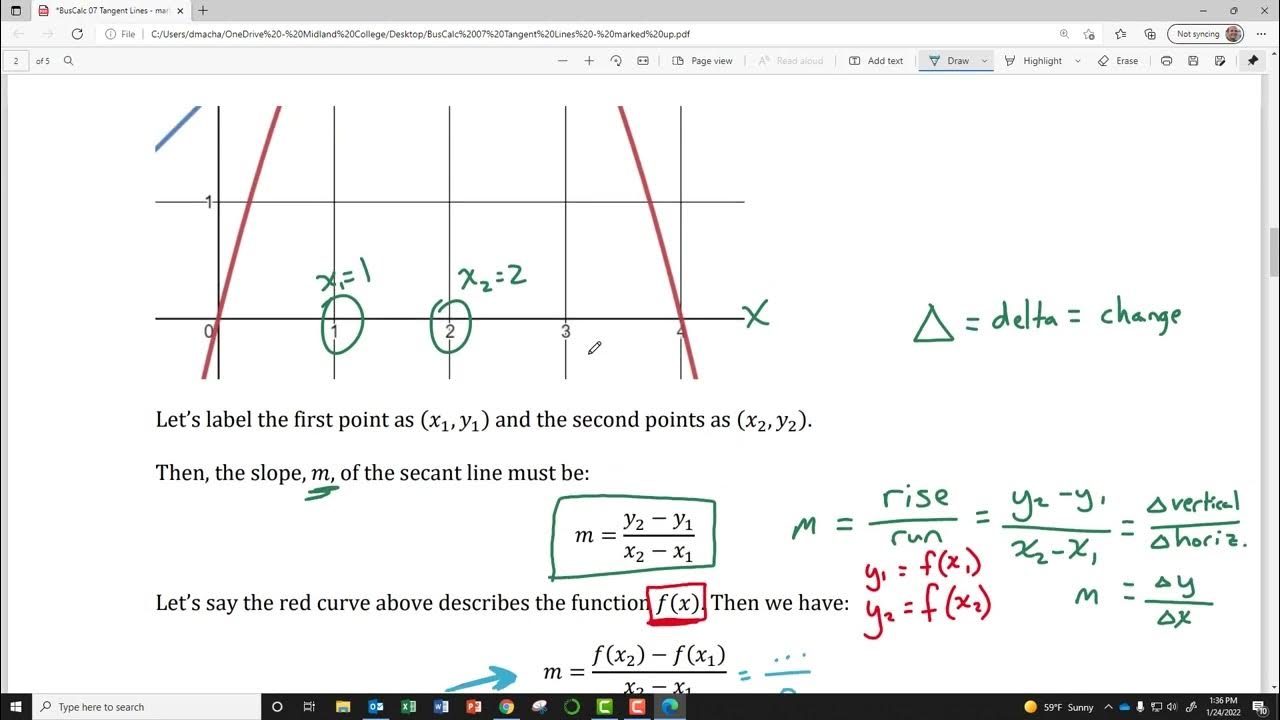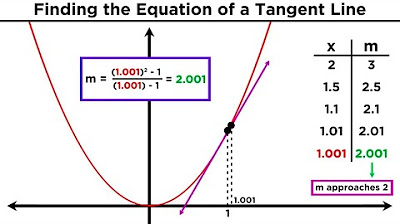Introduction to Calculus (2 of 2: First Principles)
TLDRThe transcript explores the concept of a gradient at a single point, using the analogy of a circle and its tangent to explain the transition from a secant (a line intersecting a curve at two points) to a tangent (a line touching a curve at just one point). It delves into the mathematical language of limits and the gradient function, emphasizing the importance of understanding changes and the foundational principles of calculus. The discussion highlights the evolution of mathematical notation and the introduction of new terms to describe the behavior of functions as they approach singular points.
Takeaways
- 🌀 The concept of a gradient at a single point is approached by imagining a tangent line to a curve.
- 📐 To visualize this, one can imagine a circle and a tangent line at a point on the circle, which represents the gradient at that point.
- 🤔 The challenge of calculating the gradient at a single point is addressed by considering the limit as the distance between two points approaches zero.
- 📈 The gradient of a secant line is calculated using the rise over run method, but as the distance between points decreases, this approximation becomes less accurate.
- 🔜 As the distance (denoted as 'h' or 'Δx') approaches zero, the secant line becomes a tangent, and the concept of a limit is introduced to handle such scenarios.
- 📊 The notation for the gradient of a function at a particular point is expressed using the differential notation 'dy/dx'.
- 🌟 The change in y (Δy) divided by the change in x (Δx) represents the gradient, even when both the rise and run are tending towards zero.
- 🎓 The language and notation introduced for discussing limits and gradients are fundamental to calculus and are considered the first principles of the subject.
- 🔢 The concept of limits allows for the mathematical treatment of situations where direct substitution of zero is not possible due to division or other operations that would result in undefined expressions.
- 💡 Understanding the behavior of a function as it approaches a certain point involves analyzing the trend rather than the exact value, which is the essence of calculus.
- 📚 The script emphasizes the importance of visualizing mathematical concepts, such as tangents and secants, to develop a deeper understanding of calculus.
Q & A
What is the main concept discussed in the transcript?
-The main concept discussed in the transcript is the mathematical idea of a gradient at a point, specifically focusing on the transition from a secant to a tangent line and the introduction of calculus concepts such as limits.
How does the concept of a tangent line relate to the concept of a circle?
-The concept of a tangent line is illustrated using a circle because a tangent line touches the circle at exactly one point without crossing it. This provides a visual representation of a single point of contact, which is the basis for understanding gradients at that point.
What is the significance of imagining a circle with a tangent in understanding gradients?
-Imagining a circle with a tangent helps visualize the concept of a gradient at a single point. As the length of the chord (the line segment intersecting the circle) approaches zero, it becomes a tangent line, and the concept of the gradient at that point becomes more intuitive.
How does the concept of limits play a role in understanding gradients at a point?
-The concept of limits is crucial in understanding gradients at a point because it allows us to consider what happens as the distance between two points (used to calculate the gradient) approaches zero. This approach helps us determine the gradient at a single point, which is the slope of the tangent line at that point.
What is the mathematical notation introduced to describe the gradient of a function at a particular point?
-The mathematical notation introduced to describe the gradient of a function at a particular point is the use of 'dx' and 'dy', represented as the change in y (rise) over the change in x (run), or dy/dx, which is the formal definition of the gradient or derivative of a function at a point.
Why is the term 'secant' used in the script to describe a line that intersects a circle?
-The term 'secant' is used to describe a line that intersects a circle because it provides a way to compare the gradient of a line that crosses the circle at two points to the gradient at a single point on the circle, which is the tangent line.
What is the historical context behind the development of calculus language and notation?
-The historical context behind the development of calculus language and notation is rooted in the work of mathematicians like Newton and Leibniz. They introduced new terminology and notation to better describe and calculate the behavior of functions, particularly at a single point, which was a significant advancement in the field of mathematics.
How does the concept of 'rise over run' relate to the calculation of gradients?
-The concept of 'rise over run' is a basic way to calculate gradients. 'Rise' refers to the vertical change (the difference in y-values), and 'run' refers to the horizontal change (the difference in x-values). The gradient is the ratio of the rise to the run, which gives the slope of the line.
What is the limitation of using 'rise over run' when the distance approaches zero?
-The limitation of using 'rise over run' when the distance approaches zero is that both the rise and the run tend towards zero, making the traditional calculation of the gradient undefined. This is where the concept of limits becomes essential, as it allows us to determine the gradient at a point even when the actual distance is infinitesimally small.
How does the script illustrate the transition from a secant to a tangent line?
-The script illustrates the transition from a secant to a tangent line by discussing how a secant, which intersects a circle at two points, can be approximated by drawing closer and closer to becoming a tangent. As the length of the chord (the part of the secant line inside the circle) decreases, it approaches the behavior of a tangent line, which touches the circle at just one point.
What is the practical application of understanding the gradient at a single point?
-Understanding the gradient at a single point is practically important in various fields such as physics, engineering, and economics. It allows us to determine the rate of change or the slope of a function at a specific point, which can be used to analyze the behavior of a system, optimize processes, or make predictions based on the rate of change at critical points.
Outlines
📐 Introduction to Tangents and Gradients
This paragraph introduces the concept of gradients at a point and the challenge of defining it without two distinct points for comparison. It uses the analogy of a circle and a tangent to explain the concept of a limit, where the length of a chord (SECANT) approaches zero, becoming a tangent. The explanation touches on the historical context of the language of tangents and secants and sets the stage for discussing the gradient of a tangent by examining the gradient of a secant first.
🔢 Understanding the Gradient of a Secant
This paragraph delves into the specifics of calculating the gradient of a secant line, which is essentially the rise over run. It explains how to determine the rise (vertical distance between two points on the y-axis) and run (horizontal distance on the x-axis), and how these values are used to find the gradient. The discussion then shifts towards the idea of the gradient at a single point and the challenge of having a 'gap' when the distance (run) is large. It introduces the concept of a limit, where the run (denoted as 'h') approaches zero, and the gradient of the secant approaches the gradient of the tangent.
🌐 The Language and Notation of Calculus
This paragraph discusses the evolution of language and notation in calculus to better describe the concept of a limit and the gradient at a point. It explains the shift from using 'rise over run' to simply 'change in y over change in x' (Δy/Δx) to represent the gradient. The paragraph emphasizes the importance of this notation as it allows for a more precise and adaptable way to discuss and calculate the gradient at any point on a curve, which is the fundamental principle of calculus.
Mindmap
Keywords
💡Gradient
💡Tangent
💡Secant
💡Limit
💡Function of X (f(x))
💡Coordinate
💡Rise over Run
💡Gradient Function
💡First Principles of Calculus
💡Dy/Dx
Highlights
Imagining a circle to introduce the concept of tangents and secants. (Start time: 0s)
The challenge of calculating the gradient at a single point with no two points for comparison. (Start time: 7s)
Using parallel lines to intersect a circle and the concept of chords to approach the idea of a tangent. (Start time: 14s)
The transition from the geometric concept of a chord to the mathematical concept of a limit. (Start time: 23s)
Newton's method of analyzing the behavior of a secant as it approaches a chord of length zero. (Start time: 31s)
The introduction of the Cartesian coordinate system to discuss the gradient of a tangent. (Start time: 43s)
Defining the gradient of a secant using two points on a curve and the function f(x). (Start time: 54s)
The notation and concept of 'h' as a small distance in the x-coordinate for calculating gradients. (Start time: 1m 5s)
The calculation of the gradient as rise over run, and its simplification to change in y over change in x. (Start time: 2m 21s)
The concept of a limit in calculus, allowing for the calculation of undefined forms. (Start time: 2m 42s)
The historical significance of the development of calculus by Leibniz and Newton. (Start time: 3m 14s)
The shift from the term 'gradient' for a secant to 'gradient function' for a tangent. (Start time: 3m 37s)
The use of the delta symbol (Δ) to represent change in mathematical notation. (Start time: 4m 6s)
The conceptualization of the gradient at a point as the ratio of infinitesimally small changes in y to x. (Start time: 4m 36s)
The practical application of understanding the behavior of functions at a granular level through the study of limits. (Start time: 5m 4s)
The importance of language and notation in the advancement of mathematical understanding and communication. (Start time: 5m 23s)
Transcripts
Browse More Related Video

BusCalc 07 Tangent Lines

The Tangent Line and the Derivative (Calculus)

1.4 - Differentiation Using Limits of Difference Quotients

Calculus Grade 12 Tangent

Calculating slope of tangent line using derivative definition | Differential Calculus | Khan Academy

Understanding Differentiation Part 1: The Slope of a Tangent Line
5.0 / 5 (0 votes)
Thanks for rating: